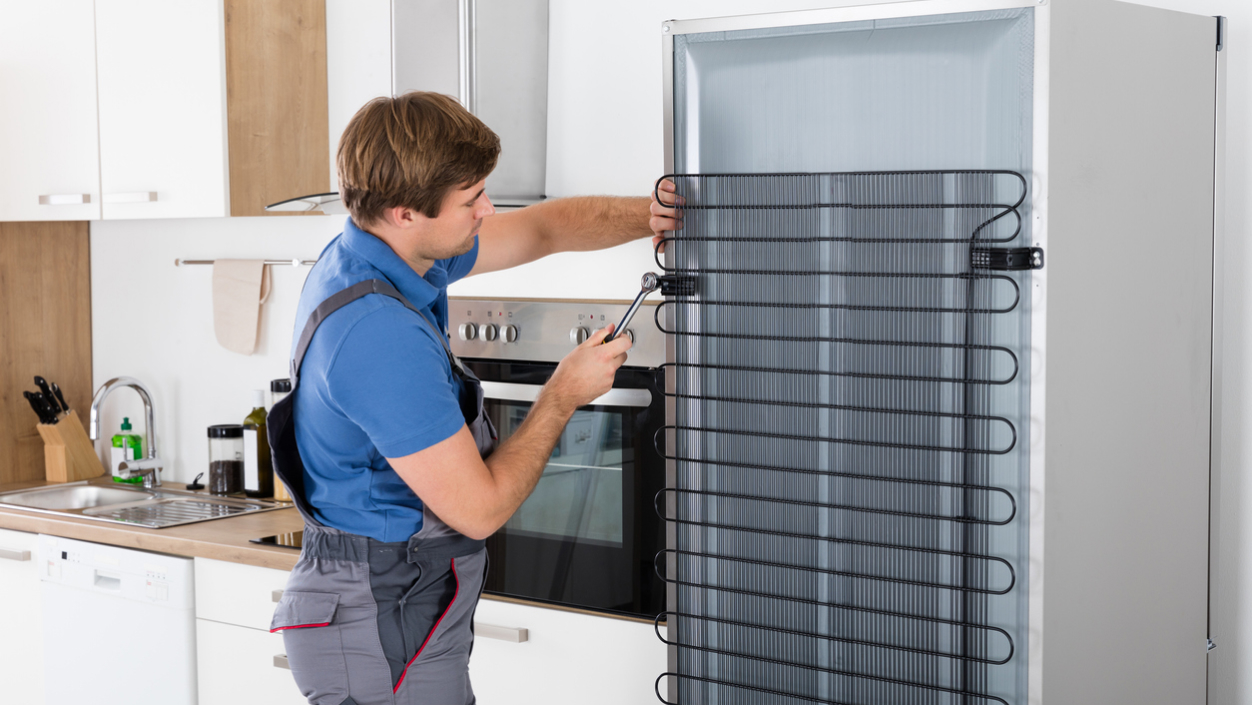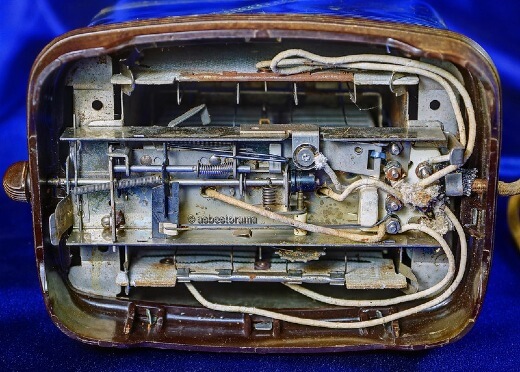Appliance Technicians and Asbestos
Appliance technicians could be exposed to asbestos when installing and repairing home appliances. An asbestos plastic resin known as Bakelite, for example, was used in appliances and countertops, which may have to be cut for new appliance installations. This could expose workers.

How Appliance Technicians Were Exposed to Asbestos
While the current risk of asbestos exposure to appliance installers and repairers is low, it is not zero because asbestos materials remain in old appliances and older homes. New appliances made in the U.S. are not made with asbestos, but appliances manufactured in other countries may contain it. No U.S. government agency is testing imported appliances for the presence of asbestos.

In 2016, the Journal of the Air & Waste Management Association published a Korean study of asbestos in appliances. The researchers investigated 414 appliances manufactured between 1986 and 2007. They detected asbestos in many large home appliances such as refrigerators and washing machines.
In 2007, the Asbestos Disease Awareness Organization presented the findings of a study conducted in the U.S. by Scientific Analytical Institute Inc. that examined over 250 products in everyday use that were suspected to contain asbestos. It found asbestos in 18 of those products, including household appliances from China. The items were purchased at national retailers during the year and a half before the testing began.
After the presence of asbestos was confirmed in these products, Sean Fitzgerald, president of Scientific Analytical Institute Inc., noted that based on the findings of this limited study, more comprehensive testing for asbestos in routine products was necessary. While the U.S. Food and Drug Administration is currently testing talc products for asbestos contamination, no other products are being routinely tested.
When technicians remodel a space to accommodate an appliance that generates a high amount of heat, they often cut away existing walls that may contain asbestos insulation. Frequently, the special heat-resistant flooring on which ovens and dryers were installed included asbestos to reduce the risk of fire.
Phenolic molding compound, manufactured under the brand name Bakelite, was a plastic resin that contained chrysotile asbestos. It was prized for its thermal and electrical insulation properties. It was not only used in the appliances themselves, but also as wall moldings that would have to be removed when an appliance installer was reshaping a space for a large appliance.
Asbestos Products Associated with Appliance Technicians

Asbestos in appliances was used to prevent fires, control heat levels and reduce chemical corrosion. It was primarily used to insulate all parts of appliances and their electrical wiring.
Asbestos insulation was used in old oven doors, paneling, seals and wire wrapping. Installation posed a low risk of exposure if the installer didn’t have to cut asbestos flooring to install the appliance. Repairing asbestos-containing ovens posed a moderate risk and released asbestos fibers into the home. While asbestos could be found in home ovens before the 1980s, it was more commonly used in industrial and laboratory ovens. Asbestos cement slabs were used in bakery and laboratory ovens, and some of these may still be in use in laboratories and industrial and commercial settings.
Old refrigerators and freezers contained asbestos wiring and insulation. Installation in newer homes poses a low exposure risk, but cutting asbestos flooring in older homes for installation purposes poses a higher risk. In-home repairs present a moderate asbestos exposure risk. Cutting asbestos wires and insulation could release asbestos fibers into the air, which could travel throughout the home.

Other large appliances, such as water heaters and washing and drying machines, contained asbestos insulation. Water heaters may contain asbestos in the insulating materials located inside the metal cover. Washers and dryers may have contained asbestos wiring and panels.
Small appliances, including toasters, bottle warmers, popcorn poppers, slow cookers and portable heaters, may contain parts made with asbestos depending on the age of the appliance. Some older portable heaters that contain coil-wrapping and insulation made from asbestos may still be in use. Appliance repair technicians dismantling old appliances remain at risk of exposure to asbestos, but the risk is low.
Manufacturers Who Made Products Appliance Installers Encounter
Companies that manufactured asbestos-containing appliances include:
- Conair: Conair manufactured an asbestos-containing hair dryer that was recalled in 1979.
- Electrolux: Electrolux claims its asbestos litigation results from externally sourced asbestos components used on appliances they manufactured before the early 1970s.
- General Electric: GE made furnaces, stovetops and the Wil-Son Patent-Flex infrared oven with asbestos materials.
- Gillette: Gillette made an asbestos hair dryer that was also recalled in 1979.
- Proctor Electric Company: This company made a toaster containing asbestos insulation.
- Sunbeam: Sunbeam also made an asbestos hair dryer that was recalled in 1979.
- Union Carbide Corporation: Union Carbide produced Bakelite, which was a type of asbestos plastic used to make knobs, trim and other parts for appliances.
- Whirlpool: Whirlpool made an asbestos washer used in oven doors.
Appliance Technicians and Asbestos-Related Diseases
According to a 2022 report by the European Commission, over 70,000 workers died in 2019 from past exposure to asbestos.
Appliance installers, repairers and technicians are at risk of developing asbestos-related diseases, including:
- Mesothelioma
- Lung cancer
- Asbestosis
- Benign pleural diseases such as pleural plaques and pleuritis
Appliance technicians may reduce their risk of occupational asbestos exposure by wearing personal protective equipment while repairing older appliances and working in older homes. It is important to learn about the types of asbestos products you may encounter to avoid exposure. Notify your employer if you suspect asbestos is present in an old appliance or home and request proper protection.
If you believe you were exposed to asbestos working on appliances, you should notify your doctor to talk about asbestos cancer screenings. Diagnosing these diseases early and seeking treatment with a specialist offers the best chance of long-term survival.

Get help finding a top attorney who can get you the compensation you deserve.
Get Help NowCompensation for Appliance Installers Exposed to Asbestos
Appliance installers and technicians have sued asbestos manufacturers after developing asbestos-related diseases, including mesothelioma and lung cancer. Personal injury lawsuits and wrongful death lawsuits filed by workers and their loved ones have resulted in compensation to cover medical costs and lost wages.
For example, appliance manufacturer Electrolux reported in December 2020 that it has 3,403 pending asbestos lawsuits. The company faced 930 new asbestos lawsuits in 2020 alone and resolved 1,424 asbestos claims that same year.
Some appliance technicians may also qualify to file claims with asbestos trust funds. Many asbestos-containing product manufacturers filed for bankruptcy protection under the weight of asbestos litigation. As part of their bankruptcy reorganization plans, they had to establish trust funds to compensate future victims.
A qualified mesothelioma attorney has the expertise to review your case and advise you on the types of claims you are eligible to file. You may be eligible to file multiple claims depending upon your exposure history.
Daniel and Mary Cain, John and Becky Cain, and Vincent and Kathleen Becker filed asbestos-related products liability claims against General Electric. The company manufactured, distributed and installed asbestos-containing products.
Whirlpool made an asbestos washer to be used in oven doors.Sunbeam, Conair Corp. and Gillette Co. manufactured asbestos-containing hair dryers that were recalled in 1979.
Recommended Reading


